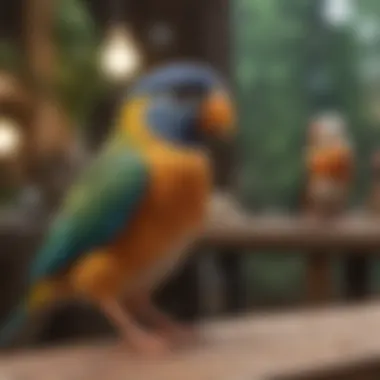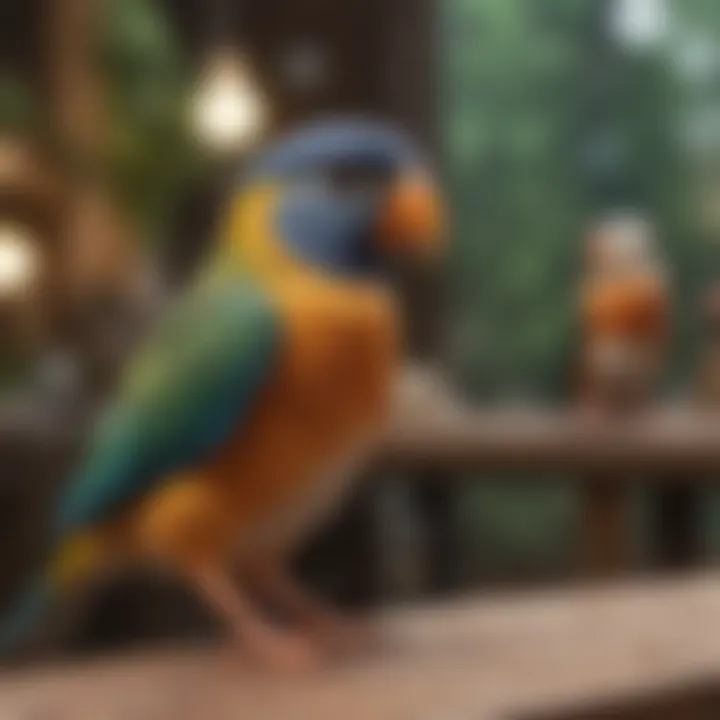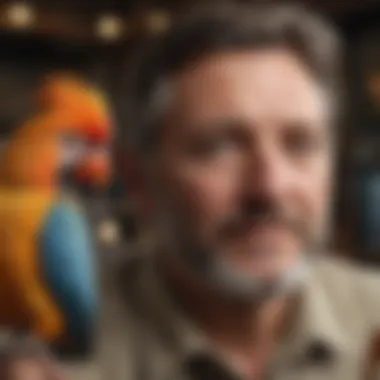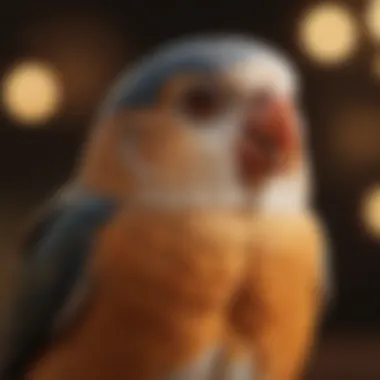Finding the Right Number of Pet Birds for You


Intro
In the realm of avian companionship, the question of how many pet birds one can adequately care for is layered with numerous complexities. Various attributes significantly impact ownership numbers; from available space to the distinct needs of bird species. Each bird comes with its own social behaviors and habitat requirements, which complicates the decision of optimal ownership.
Understanding these factors is crucial for creating a wholesome environment where pet birds can thrive. This article aims to provide essential insights into responsible bird ownership, scrutinizing ethical considerations, animal welfare, and behaviors that recur with differing numbers of birds. Whether you are an experienced enthusiast or venturing into bird ownership for the first time, recognizing how to balance these elements is key.
Care Tips
Taking care of pet birds doesn't stop at providing a cage and food. Owners must engage in daily care routines that meet individual needs. Ensure the birds get plenty of fresh food and clean water each day. Here are some pointers to guide you in establishing routines that promote health and happiness.
Daily Care Routines
- Feeding: Offer your birds a suitable diet crammed with nutrients tailored to their species requirements.
- Health Checks: Observe your birds each day. Always note their behavior, droppings, and general demeanor for any changes.
- Mental Stimulation: Rotate toys regularly to keep their environment interesting and engaging.
Cage Setup and Maintenance
Creating an optimal habitat is essential for bird well-being. The cage should offer enough space for the bird to move freely.
- Correct Size: Choose a cage that allows birds to fly and stretch.
- Perches: Install various perches at different heights for varied interests.
- Environmental Enrichment: Include safe toys and climbing structures.
Regular maintenance practices help keep the habitat hygienic.
Hygiene and Cleaning Practices
- Weekly Cleaning: Manually clean cages using bird-safe cleaners to remove waste.
- Change Substrates: Frequent replace bedding materials to eliminate odors.
Seasonal Care Adjustments
For seasonal changes, observe temperature and humidity levels:
- Summer Considerations: Maintain cooler environments, possibly employing misting or fans.
- Winter Settings: Insulate or cover cages during colder months, ensuring it's warm but not too hot.
Behavioral Insights
Understanding avian body language provides insights into their well-being. Behaviors often relate to levels of stress, comfort, or even health issues. Recognizing and responding to these signals is an essential part of responsible ownership.
Understanding Bird Body Language
- Tail Position: A lowered tail might indicate discomfort, whereas a raised one can suggest excitement.
- Vocalizations: Learning the meanings behind different sounds can reveal emotional states.
Common Behavioral Issues and Solutions
- Biting: Address with training to replace a habit.
- Plucking feathers: Immediate veterinary consultation is recommended as it may indicate stress or health issues.
Positive Reinforcement Techniques
Teach birds through rewards like preferred treats to entice correct behaviors.
Social Interaction Needs
Birds are generally social animals, particularly certain species. They require considerable interaction, either with other birds or with their human counterparts.
Nutrition Guides
Diet plays a vital role in the general health of pet birds. Owners should carefully select feeding strategies promoting optimal nutritional value.
Essential Diet Components
- Seeds and Pellets: A quality seed mix should form the primary diet alongside commercially formulated pellets applicable to the species.
- Fruits and Vegetables: Introduce a mix of fresh fruits and greens into their feeding routine.
Safe and Toxic Foods
Being aware of what to feed and what to avoid is critical:
- Toxic: Avoid avocados and chocolate.
Supplements and Treats


Some bird owners opt to add vitamin supplements. These should be discussed with a veterinarian to ensure appropriateness.
Feeding Strategies for Different Species
Each species has unique dietary needs, remember to research nutrient requirements for your birds thoroughly.
Wellness and Health
Routine check-ups contribute significantly to the overall well-being of pet birds. Ensuring a healthy, disease-free environment enhances longevity and happiness.
Routine Health Checkups
Prioritize at least annual vet visits. These baselines help to catch possible health issues early.
Identifying Symptoms of Illness
Watch for signs like lethargy, difficulty breathing, or changes in feeding behavior.
Preventative Care and Vaccinations
Talk to a vet about appropriate vaccinations and medical treatments.
Mental and Emotional Well-being
Regular interaction is necessary. The emotional happiness of the bird is as important as its physical health.
Enriching Activities
Keeping birds mentally stimulated is just as vital:
Toys and Playtime Ideas
Invest in interactive, safe toys made specifically for birds.
Training and Tricks
Engage birds by teaching simple commands or tricks that will strengthen your bond.
Outdoor Activities and Interaction
Explore the possibility of safe outdoor time supervised in harnesses or aviaries when conditions allow.
DIY Projects for Mental Stimulation
Creative setups can engage birds. Items like simple foraging devices encourage activity and curiosity.
By understanding the entirety of a bird's needs and mimicking their natural behavior as closely as possilble, owners can create a more fulfilling life for their pets.
Each degree of focus mandated by ownership of pet birds comes with its rewards, fostering meaningful relationships alongside awareness of individual limitations.
Understanding Pet Bird Ownership
Pet bird ownership involves the commitment to nurturing and caring for these unique and intelligent creatures. Understanding this commitment is crucial for any bird owner or those even considering becoming one. The importance of this understanding encapsulates several general ideas and aspects essential for responsible pet ownership.
Firstly, the unique behaviors and social dynamics of pet birds warrant careful study. Each species possesses distinct characteristics and requirements for social interaction, diet, and habitat. Such knowledge will help owners create a suitable environment that caters specifically to the needs of the bird species they choose to keep.
Secondly, prospective owners must recognize the emotional and mental wellbeing of their avian companions. Birds are social animals and thrive on companionship, whether it's from human interaction or fellow birds. The well-being of these pets depends not only on physical care but also on emotional support.
Lastly, there are legal and ethical considerations tied to pet bird ownership. Local laws may regulate which bird species can be owned, alongside defining welfare standards. An awareness of these factors underlines the importance of informed decision-making, ensuring the health and happiness of pet birds. For anyone contemplating entering the realm of avian care, exploring these elements is non-negotiable.
Prelims to Pet Birds
Pet birds stand out among companion animals due to their engaging personalities and interactive nature. Studies show that birds can bond deeply with their owners, often displaying affectionate behaviors. Familiar species include parakeets, cockatiels, and canaries. Each presents its charm but also its responsibilities for care and behavioral management.
Potential bird owners should familiarize themselves with how many different types vary in behavior, care requirements, and lifespan. Knowing such differences enables individuals to choose species that best fit their lifestyles. Moreover, understanding the environmental needs, such as specific dietary concerns and safe housing environments, fosters a healthy atmosphere for these vibrantly colored creatures.
Benefits of Owning Birds


Owning birds can impart numerous notable benefits. The following points highlight some of the core advantages:
- Emotional Enrichment: Birds can bring joy and emotional comfort to their owners. The bond formed through regular interaction enhances both human mental well-being and the welfare of the birds.
- Educative Experiences: Caring for a bird educates owners on animal behavior, zoology, and ecology, fostering broader awareness about wildlife conservation and animal welfare.
- Space-Efficient: Compared to dogs or cats, birds generally require less room. This makes them excellent companions for people in apartments or small homes.
- Aesthetics: Birds provide an additional aesthetic element to living environments. Colorful species can enhance decor and their energy adds vibrancy to daily life.
Understanding these benefits lays the groundwork for a fulfilling bird ownership experience. Careful consideration of the factors mentioned above will guide individuals in making educated choices suited for them and their feathered friends.
Factors Influencing Bird Ownership Numbers
Determining the optimal number of pet birds an individual can responsibly care for is no simple task. This section dissects the underlying considerations that influence ownership numbers. Understanding these factors is crucial for potential bird owners. Not only do they impact the wellbeing of the birds, but they also affect the experience of bird ownership.
Space Considerations
Space is one of the most significant factors in bird ownership. Birds require sufficient room to fly, play, and interact safely. For many species, a larger space can reduce stress and support physical health.
Some larger bird species, such as Macaws and Amazons, require sizeable cages. They also need the freedom to stretch their wings regularly. This makes apartment living or small homes less suitable for larger birds. On the other hand, finches or budgerigars have lower space requirements but still need ample area.
The placement of cages within a living space matters too. Cages located in quiet areas allow birds to relax without stressors such as loud noises or heavy foot traffic. Ensuring that birds have enough vertical and horizontal space is essential for their comfort and well-being.
Resource Allocation
Owning pet birds involves resource management, including time, finance, and effort. Initial costs extend beyond simply purchasing birds. Setup costs like cage, perches, toys, food, and health care are often overlooked.
Regular expenses include bird food, enrichment materials, and veterinary check-ups. For specific species, veterinary visits may not only be frequent but also financially burdensome. Financial planning is critical, as underfunding can lead to neglect of care,
Time is equally crucial. Birds require interaction and mental stimulation. A person with two hours daily must consider whether they can provide enough attention to multiple birds. Managing resources carefully impacts not only the owner's lifestyle but the birds' health as well.
Species-Specific Needs
Every bird species has unique requirements. For example, African Greys are known for their intelligence and need significant stimulation and interaction, whereas budgerigars may do well with less interaction. If a person wishes to own different species, they should account for these variation in needs.
- Diet variations: Cockatiels need pellets and vegetables, but Parakeets enjoy seeds more.
- Social habits: Some birds, like cockatoos, may experience stress if left alone for long periods. Other species, like canaries, might prefer solitude.
Understanding these needs helps establish whether it is feasible to balance various species within the same household. A shortage of any species-specific needs can result in adverse health effects.
Social Dynamics among Birds
Birds are inherently social creatures. Their social dynamics can significantly influence their happiness and overall behavior. Multiple birds, especially of the same species, can form flocks, leading to social interactions that contribute positively to their mental health. A lone bird, however, may experience loneliness and depression over time.
Not all birds will socialize well together. Factors such as territory and aggression can complicate relationships. For example, two males of certain species may fight for dominance. Therefore, careful introductions and monitoring are necessary to ensure harmony.
Moreover, when introducing new birds, observing established social structures within the known flock is important. Birds may see newcomers as threats rather than companions, affecting their integration into the home.
Understanding these dynamics is essential. It helps in reducing stress among birds, facilitates easier management of relationships in multi-bird households, and supports a healthy environment for both individual birds and the flock as a whole.
Evaluating the Bonding Needs of Birds
Understanding the bonding needs of pet birds is essential when determining how many avian companions one might care for. Each specie of bird has its own hierarchies and social structures that influence their energy levels and interaction preferences. The bonding aspect is not only about meeting the social needs of birds but also enhancing their overall well-being. This section examines two critical areas: the importance of social interaction, and the effects of isolation on behavior.
Importance of Social Interaction
Birds are inherently social animals. Engaging with them plays a significant role in their development and well-being. Many species of pet birds, such as budgerigars and cockatiels, thrive on interaction, both with their human caregivers and with other birds.
- Social stimulation: Birds engage in behaviors influenced by their desire to socialize. These activities include vocalizations, preening each other, and playing. Each interaction decreases behavioral irregulations sometimes seen in less interactive bird environments.
- Training and learning: The ability to bond with their owner encourages birds to learn tricks and commands more rapidly. This not only strengthens the human-bird relationship but also fosters good mental health, as trained birds tend to emerge less stressed and more confident.
- Reduction of boredom: Interactive play can provide entertainment and mental exercise. This is particularly vital for single birds who might otherwise feel lonely or inactive due to an absence of social roles.
In short, investing time in social interactions elevates the well-being of pet birds. Owners must consider that more birds result in more potential for enriching interactions but could also lead to increased complexity in understanding each bird's social needs.
Effects of Isolation on Behavior
Birds left in isolation can experience numerous behavioral issues that can not only affect their quality of life but also the harmony within a household. Misunderstandings arise when neglecting birds' innate social tendencies.
Some common effects include:
- Destructive behaviors: Birds, particularly when bored or isolated, sometimes resort to destructive behaviors. These may include excessive chewing, plucking feathers, or initiating vocal outbursts.
- Fearfulness and anxiety: Loneliness can cause high anxiety levels in birds. When they lack interaction with either other birds or human caregivers, they might become fearful, exhibiting signs such as fluffed feathers, aggression, or timid responses to stimuli.
- Health decline: Prolonged isolation can lead to several health issues. Stress-induced sickness can occur when a bird is socially deprived. Poor immune beahvior, among others, may lead to susceptibility to numerous diseases.
Adopting multiple birds might provide necessary companionship, preventing the adverse effects of isolation. However, it's important to note that more birds mean a deeper understanding of their yearning for social needs, which creates an opportunity for enriching experiences and scenery. Achieving a balance among social dynamics is vital for fostering healthier, happier pet birds.
Birds should be seen not just as pets but as vibrant companions that contribute to the dynamic of a living school of avian life.


Potential Challenges of Multiple Bird Ownership
Owning multiple pet birds presents various challenges that deserve careful consideration. While the joys of these avian companions are undeniable, understanding the potential difficulties ensures responsible ownership. Issues of aggression, health management, and spatial requirements can significantly affect both the birds' wellbeing and the owner's experience.
Aggression and Territoriality
Birds are known for their dynamic social behaviors; however, sometimes they can display aggression, especially in a multi-bird environment. Different species have varying temperament and aggression levels. For instance, larger species like macaws may show more territorial tendencies compared to smaller parakeets.
- The introduction of a new bird can result in stress, which may trigger aggression in established birds.
- Hierarchies among the birds can lead to conflicts, affecting feeding and resting habits.
- Insufficient space can intensify territorial disputes, leading to physical confrontations. Understanding each bird's personality and implementing gradual introductions can mitigate aggressive behaviors.
Health Management Across Species
When considering the health aspect, multiple bird ownership complicates routines. Each species comes with unique healthcare requirements, making it challenging to maintain overall wellbeing. For instance, a cockatiel may require different dietary ingredients than a lovebird.
- Regular vet check-ups are critical to ensure all birds maintain optimal health.
- Preventive measures like vaccinations should be species-specific, addressing each group's individual vulnerabilities.
- Managing chronic conditions across various species could mean different medications, which can be overwhelming. Owners need a robust health plan, ideally tailored for mixed-species situations.
Space and Cage Considerations
One of the most important aspects of multiple bird ownership is the space available. Different dwellings, such as apartments or houses, dictate how many birds can safely coexist. A cramped environment can lead to stress and behavioral issues.
- Ideally, each bird should have enough room to move freely without feeling crowded.
- Spacious cages equipped with various perches and toys can help encourage positive interactions while avoiding potential disputes.
- Multi-level cages are an efficient solution for accommodating numerous birds, providing zones for different activities. Adhering to species-specific needs for space is essential to prevent issues arising from overcrowding.
In summary, while the idea of multiple pet birds might be appealing due to their engaging nature and companionship, potential challenges can intertwine with their unique needs and personalities. Understanding aggression dynamics, health management, and space considerations will pave the way toward a more harmonious coexistence among avian friends.
Determining the Right Number for You
Understanding the right number of pet birds to own is fundamental for responsible bird ownership. The lives of these creatures depend not only on proper feeding and housing but also on deciding how many can be cared for mentally and physically. Each individual must assess their capabilities, set goals, and be conscious of the prevailing laws in their area before adopting multiple birds. Distinguishing one's own limitations and lifestyle can lead to a precarious balance of fulfilled bird lives, optimal care, breeding commitments, and harmony within the home.
Assessing Your Personal Capability
To determine how many pet birds one can properly look after, introspection is necessary. This involves evaluating time, money, and energy dedicated to their care. For instance, consider how much time is available in daily life, as birds require time for social interaction, environmental stimulation, and exercise. Working individuals may find it demanding to manage larger flocks while providing adequate attention to each. The costs pile up quickly, involving not only feed and supplies but also veterinary care which is crucial for bird health.
Furthermore, room must be made for both bird cages and play areas. Larger birds like cockatoos would require significant floor space, while smaller birds might require less, depending on the number. Lack of focused time can lead to unwanted behaviors, manifesting as anxiety or aggression, which could evolve into fighits or social issues in a larger group. Each owner must reflect on what is realistic.
Setting Realistic Goals
Establishing achievable goals significantly enhances ownership satisfaction and bird health. One should ask themselves what they wish to achieve with their pet birds. For some, a companionship model works; while for others, it might involve creating a small flock.
Here are a few elements to take into account:
- Consider the species of birds: Different species come with varying needs and flood dynamic nuances in interactions.
- Decide on activity levels: Differently paced lifestyles argue the case for a set number of birds.
- Piecing In Mediation: If fulfillment rests only on hormonal signals of breeding, ownership wood aim too high; embrace realistic connection levels instead. Advanced interactions will foster caring duties effectively, through gradual shifts toward ownership schemes over time.
While aiming high inspires growth and enrichment, often, lower numbers remain pertinent to maintain a peaceful household environment. Often, finely balancing achievement and self-sufficiency necessitates gradual trials.
Understanding Local Regulations
Knowledge of local laws and governing regulations is paramount when planning to own multiple birds. Some regions implement limits on the number of pets in local ordinances. Ignorance regarding these rules can unjustly put owners at risk, leading to fines or required adoption rescues.
Locally governed laws may dictate:
- Type and number of specific birds people may own. Some birds might be classified as endangered under certain jurisdictions.
- Licensing to keep specific species; exotic birds may require state permissions extensively.
- Incorrect housing builds resulting in unsustainable housing stocks.
Bird owners should seek guidance on standards and local compliance as each locality retains textured coatings involving characteristic bird groups. Always look for mutual agreements suitable for your area before beginning one's pet bird journey, and check your area's regulations at wikipedia.
By carefully framing these considerations, pet bird owners can map out a concrete yet adaptable plan for how many birds they can cater to, benefiting both their lifestyle and the birds’ welfare.
The End
The conclusion serves a vital role in reinforcing the concepts discussed throughout the article. It encapsulates critical insights to empower individuals in determining the optimal number of pet birds for sustainable and responsible ownership. Recognizing the balance between the desire for companionship and the practical aspects of care ensures both the birds and their owners can thrive together.
Summarizing Key Points
Throughout the article, we explored important considerations when deciding how many birds to bring into your home. Key points include:
- Understanding Your Capabilities: Individuals must evaluate their space, time, and financial resources comprehensively before acquiring multiple birds. This is essential to providing each bird with the care they need.
- Species Needs and Behavior: Different bird species have unique social and environmental requirements. For instance, some thrive better in social settings while others may prefer solitude.
- Health and Well-being: Managing the health of multiple birds can become challenging, particularly when including different species with varied needs. Common issues such as aggression due to territorial behavior must be recognized and mitigated through careful planning.
- Emotional and Ethical Responsibility: Adopting any pet entails a level of emotional investment and ethical accountability that must be prioritized. It is crucial to ensure an enriching environment that meets the welfare needs of each bird.
Final Recommendations
The journey of pet bird ownership should be viewed with caution and thorough consideration. Here are some recommendations to guide potential and current bird owners:
- Assess Your Environment: Ensure that your living space accommodates the specific needs of the number and species of birds you intend to keep.
- Prioritize Personal Time: Establish routines that allow for sufficient interaction and playtime with your birds, vital for their emotional health.
- Research Thoroughly: Invest time in learning about the species you are interested in. Resources such as Wikipedia and Britannica can provide deeper insights into individual species.
- Consider Future Growth: Think long-term about your setup and plans for any potential expansion in numbers.
A considered approach emphasizes a deeper understanding of leadership in the journey with pet birds, mitigating several challenges and fostering lasting companionship.















